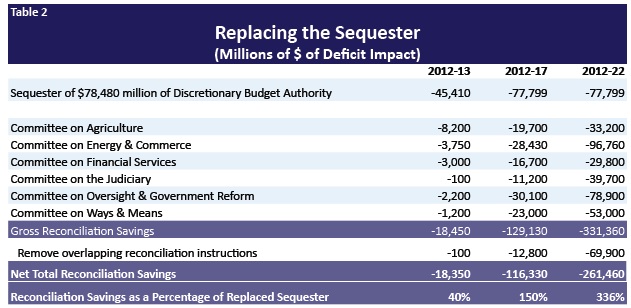The House Republican Approach to the Sequester
One of the more complicated aspects of Rep. Paul Ryan's (R-WI) budget is what he does with the sequester that will take effect on January 2, 2013 due to the failure of the Super Committee. From 2013-2021, the sequester is scheduled to reduce the deficit by $984 billion, with $66 billion coming in 2013. The sequester essentially has three parts: cuts to defense spending, cuts to non-defense spending, and cuts to mandatory programs, including Medicare (limited to two percent).
The Ryan budget takes a different approach to each of the three parts sequester. In FY 2013, it repeals $78 billion of the $94 billion in discretionary cuts called for by the sequester--leaving $16 billion of non-defense discretionary cuts and the entirety of the $16 billion of mandatory cuts--and then uses "reconciliation" instructions to pay for the cost. In particular, it calls for savings from six committees which together would be sufficient to pay for the $78 billion deficit increase over only a few years. By 2017, those instructions call for $116 billion in cuts (150% of the cost) and by 2022 it calls for $261 billion in savings (336% of the cost).
The budget does not explicitly endorse any policies for reaching these savings, but options such as increasing federal employee pension contributions, enacting medical malpractice reform, and means-testing entitlements are mentioned.

As for 2014 and beyond, the budget essentially leaves the sequester fully in place. On the mandatory side, the sequester is allowed to cut spending across-the-board to various programs. On the discretionary side, the budget retains the overall levels of the sequester but keeps them classified as "allowances" -- which is budget speak for unspecified savings. In this way, it allows the apparent defense numbers to substantially exceed sequester levels (and BCA levels as well), while counting all of the sequester savings on the non-defense side.
| Discretionary Spending, Ryan vs. BCA (billions of budget authority) | |||||||||||
| 2013 | 2014 | 2015 | 2016 | 2017 | 2018 | 2019 | 2020 | 2021 | 2022 | ||
| Ryan Budget | |||||||||||
| Defense | $554 | $567 | $580 | $594 | $610 | $626 | $644 | $662 | $680 | $699 | |
| Non-Defense | $474 | $406 | $414 | $421 | $430 | $439 | $449 | $458 | $466 | $477 | |
| Total | $1,028 | $973 | $994 | $1,016 | $1,040 | $1,066 | $1,093 | $1,120 | $1,147 | $1,176 | |
| BCA With Sequester | |||||||||||
| Defense | $491 | $501 | $511 | $522 | $535 | $548 | $561 | $575 | $589 | $605 | |
| Non-Defense | $458 | $472 | $482 | $493 | $505 | $517 | $531 | $545 | $557 | $572 | |
| Total | $949 | $973 | $994 | $1,016 | $1,040 | $1,066 | $1,093 | $1,120 | $1,147 | $1,176 | |
| BCA Excluding Sequester | |||||||||||
| Defense | $546 | $556 | $566 | $577 | $590 | $603 | $616 | $630 | $644 | $661 | |
| Non-Defense | $501 | $510 | $520 | $530 | $541 | $553 | $566 | $578 | $590 | $605 | |
| Total | $1,047 | $1,066 | $1,086 | $1,107 | $1,131 | $1,156 | $1,182 | $1,208 | $1,234 | $1,266 | |
Note: Numbers may not add up due to rounding


